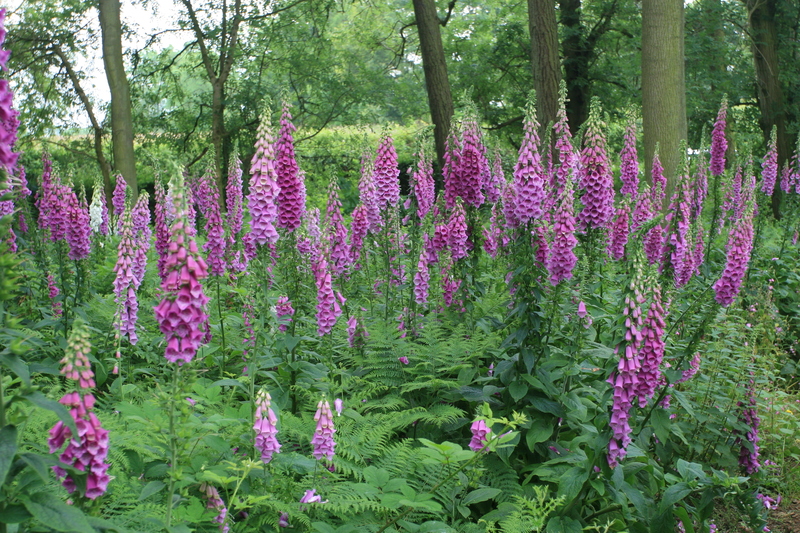Vertical Gardening: Bringing Nature to Tall Urban Structures
Posted on 04/06/2025
Vertical Gardening: Bringing Nature to Tall Urban Structures
Vertical gardening has rapidly become a transformative trend in urban landscape design. As cities grow vertically, so does our need to reconnect with nature. By integrating vibrant greenery into skyscrapers, high-rises, and city walls, vertical gardens are turning concrete jungles into lush, living spaces. In this comprehensive guide, we'll explore the world of vertical gardening for tall urban structures, its benefits, challenges, and strategies for successful implementation.
The Rise of Vertical Gardening in Urban Landscapes
Cities are continually expanding upward, and traditional ground-level gardens often aren't feasible for urban dwellers. Vertical gardens, also known as living walls or green facades, offer an innovative solution. These lush installations not only bring aesthetic beauty but also tackle pressing environmental issues associated with urbanization.
What is Vertical Gardening?
Vertical gardening is the practice of growing plants on vertically suspended panels, structures, or frameworks. These can cover external or internal walls, acting as living insulation, air filters, and even food sources. By employing hydroponic or soil-based systems, vertical gardens utilize unused vertical spaces in creative and impactful ways.
The History and Evolution of Vertical Gardens
While the concept may seem modern, vertical gardening traces its roots to historical marvels such as the Hanging Gardens of Babylon. Contemporary vertical gardening has evolved with advancements in horticulture and architecture, now found in famous buildings from Paris to Singapore to New York.

Key Benefits of Vertical Gardening on Tall Structures
- Improved Urban Air Quality: Plants on vertical surfaces absorb pollutants, dust, and CO2, making city air cleaner and healthier.
- Thermal Insulation: Vertical gardens act as natural insulators, reducing the need for artificial heating and cooling in buildings.
- Biodiversity Enhancement: Green facades provide habitats for birds, bees, and beneficial insects in otherwise sterile environments.
- Noise Reduction: Layers of foliage absorb and deflect urban noise, creating peaceful indoor and outdoor spaces.
- Aesthetic Appeal and Well-being: The presence of greenery elevates mental health, promoting relaxation and productivity.
Eco-Friendly Advantages
Urban environments face the challenge of the urban heat island effect, where concrete and asphalt absorb and radiate heat. Vertical gardens help moderate building temperatures, lower energy consumption, and contribute to city-wide cooling.
Types of Vertical Gardens for Skyscrapers and High-Rises
Vertical garden systems can be tailored to suit various building types and climates. Here's a breakdown of the main types:
- Green Walls: Modular panels filled with plants are attached to building exteriors or interiors. These walls are often hydroponic and include integrated irrigation.
- Green Facades: Vines and climbers grow along trellises, mesh, or wires installed on building surfaces. They generally use soil beds at the base and naturally climb upward.
- Living Wall Art: Smaller installations designed as decorative features, transforming indoor spaces such as lobbies or reception areas.
- Edible Vertical Gardens: Incorporating vegetables, herbs, and fruits for urban agriculture, often for on-site restaurants or community initiatives.
Choosing the Right System
Each system has unique requirements for plant selection, maintenance, and irrigation. The choice depends on factors such as sunlight exposure, local climate, available space, and structural support.
Design Principles for Vertical Gardens on Tall Urban Structures
Implementing a vertical garden on a high-rise involves more than simply attaching planters to a wall. Below are essential design considerations:
1. Structural Assessment
Not all facades can immediately support the weight of a fully installed living wall. Engineers must assess load-bearing capacities to ensure safe, long-term deployment.
2. Plant Selection
Plants must be drought-tolerant, wind-resistant, and suitable for local conditions. Common choices include ferns, succulents, grasses, and native flowering plants. For edible walls, herbs like basil, mint, and oregano thrive in city environments.
3. Irrigation and Drainage
Automated watering systems reduce labor and ensure consistent moisture levels. Efficient drainage prevents root rot and excess weight due to waterlogging.
4. Sunlight and Wind Exposure
The orientation of the wall dramatically influences plant health. South-facing walls, for example, need plants that tolerate more sun, while higher elevations may require species that withstand strong winds.
5. Maintenance Accessibility
Vertical gardens on tall buildings must be designed for safe, easy maintenance. Modular panels allow for quick replacement and servicing of individual sections.
Successful Examples Around the Globe
- One Central Park, Sydney, Australia: This iconic residential tower features one of the world's largest vertical gardens, designed by botanist Patrick Blanc, with over 38,000 plants.
- Museo del Acero, Monterrey, Mexico: The museum's green facade absorbs pollutants and provides an innovative contrast to the industrial surroundings.
- Bosco Verticale, Milan, Italy: Often cited as a "vertical forest," these twin towers host over 900 trees and thousands of shrubs, supporting urban biodiversity in the heart of Milan.
- Edificio Santalaia, Bogota, Colombia: With 3,100 square meters of lush plants, this residential building purifies air for the equivalent of more than 3,000 people.
Challenges and Solutions in Vertical Gardening for Urban Structures
While urban vertical gardening brings significant benefits, it also presents several challenges:
Common Obstacles
- Structural limitations due to the added weight and moisture exposure.
- Maintenance difficulties, especially at great heights.
- Initial investment in construction, irrigation systems, and suitable plant stock.
- Pest and disease management in a concentrated planting area.
- City regulations and building codes affecting green wall installations.
Innovative Solutions
- Lightweight modular panels made from recycled materials reduce the load on facades.
- Smart irrigation technology optimizes water usage and delivery based on real-time environmental data.
- Remote monitoring and automated care systems minimize manual labor and swift identification of issues.
- Collaborative design with local authorities and architects ensures vertical gardens meet all safety and regulatory requirements.
Step-by-Step Guide: How to Install a Vertical Garden on a Tall Building
Building a vertical garden on a tall urban structure is a multi-stage process that requires collaboration between architects, engineers, horticulturists, and maintenance staff. Here's a basic outline:
- Conduct a building assessment: Review structural integrity, exposure, and access points for installation and maintenance.
- Choose a vertical garden system: Based on climate, intended use (ornamental or edible), and building aesthetics.
- Select appropriate plant species: Opt for low-maintenance, native, or proven urban varieties.
- Design irrigation and drainage: Integrate efficient, automated watering systems that minimize water use and direct runoff safely.
- Install support structure and panels: Ensure all materials are securely fixed and able to bear the expected load.
- Plant and establish garden: Begin with smaller plants that can mature in place, guaranteeing healthier growth and adaptation.
- Schedule routine maintenance: Build in regular inspections, pruning, and system checks to ensure long-term success.
Tip: Early consultation with vertical gardening experts will help streamline every stage and prevent costly mistakes.
Maintaining a Healthy Vertical Garden on High-Rise Structures
Proper upkeep is crucial for the longevity of green walls. Urban environments subject plants to harsh winds, fluctuating temperatures, and pollution. Maintenance plans should include:
- Regular irrigation system inspections
- Pruning and replacing unhealthy plants
- Feeding with appropriate nutrients
- Integrated pest management (IPM) techniques
- Monitoring structural integrity of wall panels and supports
Leveraging Technology
Advancements in IoT (Internet of Things) allow for the remote monitoring of soil moisture, temperature, and plant health. Automated irrigation and fertilization systems further enhance efficiency and reduce labor costs.

The Future of Vertical Gardening in Urban Architecture
As cities continue to densify, the integration of nature-inspired design practices is no longer a luxury but a necessity. Vertical gardens play a pivotal role in bridging the gap between urban development and environmental sustainability.
- Urban Farming: More high-rises are incorporating edible vertical gardens to supply fresh produce and herbs locally, reducing food miles.
- Smart Green Cities: The combination of data-driven management and biophilic design promises even greener urban landscapes globally.
- Wellness and Mental Health: Access to nature, even in vertical form, is now recognized as a key factor in workplace productivity and public health.
Governments, architects, and communities are increasingly prioritizing policies that support large-scale vertical landscaping. Grants, tax incentives, and green building certifications (such as LEED) often reward projects that integrate vertical greenery.
Conclusion: Embracing Vertical Gardens for a Sustainable Urban Future
Vertical gardening on tall urban structures is more than just a trend--it's an essential response to modern urban challenges. These living walls improve city air quality, help regulate temperature, foster biodiversity, and restore our vital connection to nature in the most unexpected places.
Whether you're a developer, architect, city planner, or an urban resident dreaming of greener skylines, vertical gardens offer untapped opportunities for creative, sustainable design. By bringing nature to tall buildings and city streets, we can create healthier, happier, and more resilient cities for generations to come.
Frequently Asked Questions about Vertical Gardening on Urban Structures
- Can vertical gardens survive harsh urban climates? Yes, with proper plant selection and automated care systems, many vertical gardens thrive in challenging urban settings.
- Is it expensive to install and maintain a vertical garden? While initial costs can be high, energy savings, increased property value, and improved well-being often justify the investment.
- Can I grow vegetables or herbs on a vertical wall? Absolutely! Edible vertical gardens are gaining popularity, especially in residential and hospitality buildings.
Ready to transform your urban space? Explore the world of vertical gardening and join the movement to bring nature back to our cities--one wall at a time.

